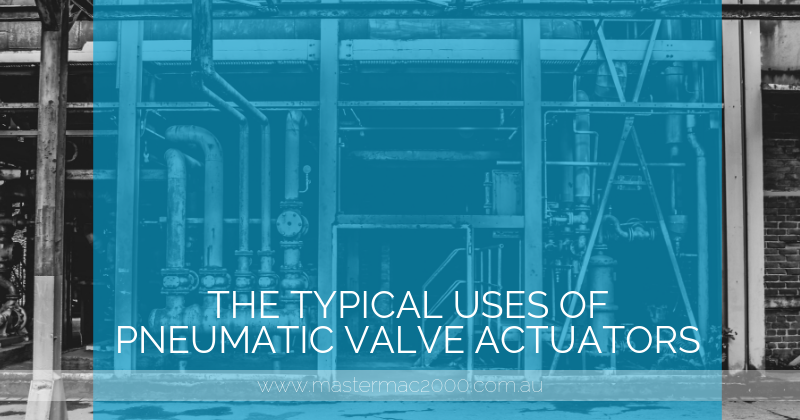The Typical Uses of Pneumatic Valve Actuators

Pneumatic valve actuators are mostly used in industrial applications such as in chemical plants, construction ventures, oil refineries, underwater marine mining, and water management. They are usually made up of materials like aluminium, plastic, and stainless steel. Those that were made of steel are common in industries where complex pipe and product delivery conduits are used to manage corrosive liquids.
With regards to turtorq actuators, they are widely utilised in engineering and industrial applications. This is because the said industries require precise movements, especially with gearboxes and positioning components. They make use of computer-controlled systems in regulating the amount of compressed air required to maintain precision movement. Such systems are managed from remote locations where corrosive chemicals and liquids are being directed or transported.
In chemical manufacturing plants, where products are dangerous and hazardous, manual butterfly valves are installed in the same pipe segment individually or integrated into pneumatic valves actuators to address safety and security precautions. Flow sensors that are installed within valve actuators connecting to a central management system further promote safety. The said systems monitor and manage fluid flow within the pipe networks individually and groups. They offer a multitude of commercial benefits that outrank the use of hydraulic actuators. One is their ability to store energy dedicated to emergency uses whenever there is an electric interruption. Another is their ability to operate during massive energy charges, but the energy is not absorbed in the compressed gas system. These features make pneumatic valve actuators the best choice when dealing with industrial systems.
However, these actuators do not function well in sub-zero situations. Fortunately, there are complex versions that exist, delivering compression through heated air systems that easily operate in extremely cold climates. The fluid delivery networks that are situated in these type of environment oftentimes have back-up or redundant systems to prevent production downtime that could greatly impact the production delivery and schedules.
Emergency and fail-safe systems are required in demolition projects, underwater mining operations, and other complex liquid and fluid direction systems. Such systems help regain control or override management systems if failures or other serious malfunctions occur. They can be managed through mobile controls that can be deployed in minutes.
Precise direction and flow of chemicals, corrosive liquids, and dangerous fluids need robust hardware that is capable of functioning under high payloads, while maintaining flow direction and precision movement within intricate pipe networks. These systems rely on the power of pneumatic valves actuators.
If you want to learn more about this topic, contact Mastermac2000.com.au today!

About MasterMac2000: Your Trusted Pneumatic & Process Automation Partner.
LEADING THE INDUSTRY: Established in 1989, MasterMac2000 has grown to become one of Australia's largest privately owned pneumatic and process automation companies. We stock top-quality brands like Univer, Mack, Tolomatic, Mac, Piab, American, and Rotoflux in Brisbane.
SERVING QLD & NORTHERN NSW: We proudly service Queensland and Northern New South Wales for all your pneumatic and process equipment needs. Our mission is to provide the best pre and post-sales support while actively expanding our client base.
SOURCING HARD-TO-FIND PARTS: Not only do we stock quality components, but we also excel at sourcing those elusive, hard-to-find parts. With our extensive database and global network of contacts, getting the parts you require is as easy as a call to our highly skilled, professional sales team.
DEDICATED TO YOUR SUCCESS:
- Decades of expertise in pneumatics & process automation
- Carefully curated selection of world-class brands
- Exceptional sourcing capabilities for speciality parts
- Knowledgeable sales staff dedicated to finding solutions
- Unwavering commitment to customer service excellence
About The Author
Stuart Havill
Stuart Havill is the owner and manager of MasterMac2000, Queensland's largest privately owned pneumatic and process valve company.
With his early working career as a maintenance fitter for Boral in 1992, Stuart has spent his life in the field of pneumatics and process equipment. He gained extensive experience in plant design, maintenance, repairs, fabrication, and site management.
In 1996, he transitioned to a pneumatic sales technician role at MasterMac2000, where he excelled in key account management, providing cost-effective solutions, and managing a sales team of 9 employees.
Since 2002, Stuart has been the manager at MasterMac2000, overseeing the company's growth and establishing it as a leader in pneumatic automation and process valve engineering. His expertise spans customer training, CRM setup, industrial compressor sizing and installation, and turn-key project management.
Under Stuart's leadership, MasterMac2000 has been servicing the industry since 1988, with 5 full-time sales representatives covering northern rivers NSW, Queensland, Northern Territory, and PNG. The company prides itself on providing the best-priced solutions to all customers in the marketplace.
View Stuart’s LinkedIn profile to learn more about his expertise in pneumatics and process equipment.